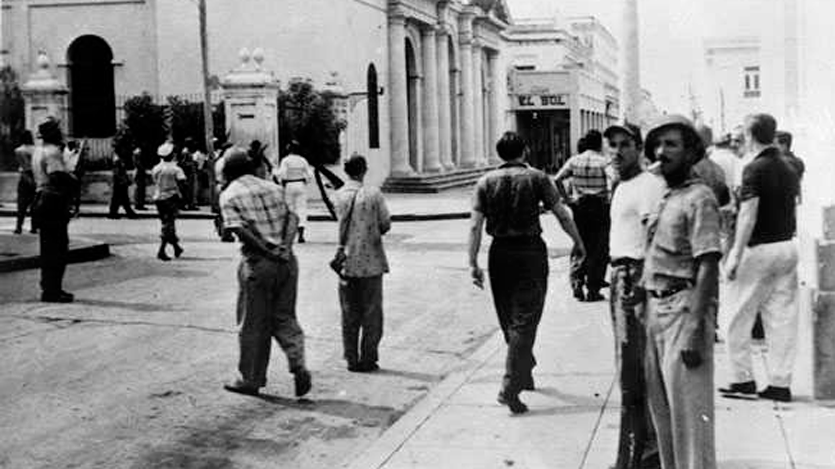
Members of the July 26 Movement, some officers and members of the Navy and the people in general, on September 5, 1957, rose up in an uprising that made history by confronting Batista's best-equipped army with weapons in the central city of Cienfuegos.
Despite the unequal forces, such an action full of courage and audacity in support of the open insurrectional campaign in the Sierra Maestra, placed the Pearl of the South in the center of the heart of the Homeland, although it did not achieve its tactical objectives.
It was a day in which valuable children of that land lost their lives, so remembering it is an action of sacred memory.
Fidel valued it as a truly determined and heroic fight years later.
He responded to the growing awareness of the Cuban people that the frontal struggle was already in those times the way to achieve the most suitable justice within the national territory, with the spirit of those who had already been fighting since the end of 1956 in the eastern mountains. .
The assault carried out in Cienfuegos continues to be full of glory after so many years. On each anniversary the children of those domains make a pilgrimage from José Martí Park to the cemetery where the remains of the heroes massacred by the dictatorship, who participated in the attack, rest.
The insurgency took over Cayo Loco and other enclaves of a city that, enraged, had the courage to challenge the corrupt and murderous power, and support them in an instructive day of light and dedication in which its population lived 24 hours feeling complete freedom.
What represented a moment in time revealed to the compatriots how firm the decision to fight was that was being forged in the Cuban youth and people again in those times.
It was to be expected and it happened: the rebels and their followers could not face the brutal onslaught of a well-equipped armed force, supported by superior resources in men and weapons, plus their criminal cruelty. Batista's repression caused dozens of deaths, injuries and mutilations in his desire to abort the action, but he never imagined that the act of rebellion was in itself a moral victory of incalculable value that would reach resonance throughout the country.
However, they surprised the dictator, who did everything to decimate, hit and dismantle the M-26-7 and its approaches to other progressive forces in the also called Pearl of the South, and this later made itself felt.
It had been conceived by the revolutionaries that the maneuver in the central-southern territory was part of a chain of insubordinations planned at the national level, which included assaults on the Presidential Palace and the General Staff of the Navy in Havana, and combats in Santiago from Cuba.
The magnitude of such a plan demanded more preparation time and only those involved in this last point - Cienfuegos - could not receive the order to postpone the uprising and executed it, according to the previously agreed upon date, September 5.
Initially, the action was expected to be carried out in April, then it was specified on May 28. However, it had to be postponed, first due to technical failures and then due to denunciations that added danger to the lives of its already risky participants and the effectiveness of the combative endeavor itself.
Julio Camacho Aguilera, then appointed military chief of a group of officers in that town, was at the forefront of that bold initiative that sought to take the entire city, in addition to the maritime police, the radio and communication stations and the headquarters of the Rural Guard.
There were achievements in taking key sites in a battle that lasted almost all day. And he was able to enjoy the joy of seeing the city in the hands of genuine patriots.
Fidel, in his speech for the 20th anniversary of this uprising, stated:
“No one is able to imagine the extraordinary help that the uprising scheduled for May 28 and the opening of a second guerrilla front in the Escambray mountains would have meant for the combatants of the Sierra Maestra.
“(…) the fact of the Cienfuegos uprising meant an extraordinary moral encouragement for the combatants of the Sierra Maestra. The tyranny could no longer continue talking about the unity of its armed forces. It is worth noting that this phenomenon that occurs in Cienfuegos is extremely interesting, because there is no doubt that the tyranny remained supported by the armed forces.
“We couldn't maintain the Key then, we couldn't maintain the San Lorenzo School, nor the City Hall, nor Martí Park, nor the city... We didn't take it then, but we took it later, and our people have it now definitively and forever. And today we are owners of our Homeland, not only because we knew how to conquer it, but because we also knew how to defend it with dignity and heroism,” stated the Cuban Leader.
At the stroke of midnight the revolutionaries, punished by lack of ammunition and exhaustion, concluded their battles. And the predictable happened. A wave of torture, murder and persecution awaited them, very much in the barbaric style of a tyrant who filled the country with mourning, while enriching himself in the heat of surrender to foreign capital and the oligarchy.
But the inspiring freedom of such sacrifice finally arrived with the dawn of January 1959. Cienfuegos and Cuba do not forget their best sons, immolated on September 5, 1957. In many places in the town that serenely looks at the Caribbean, they remember the action, such as the old San Lorenzo School, one of the main settings, today called “5 de Septiembre” Basic Secondary School. (Text and photo: ACN)